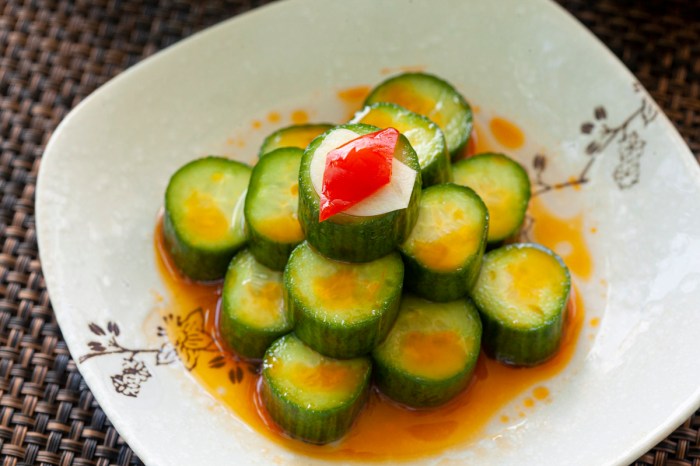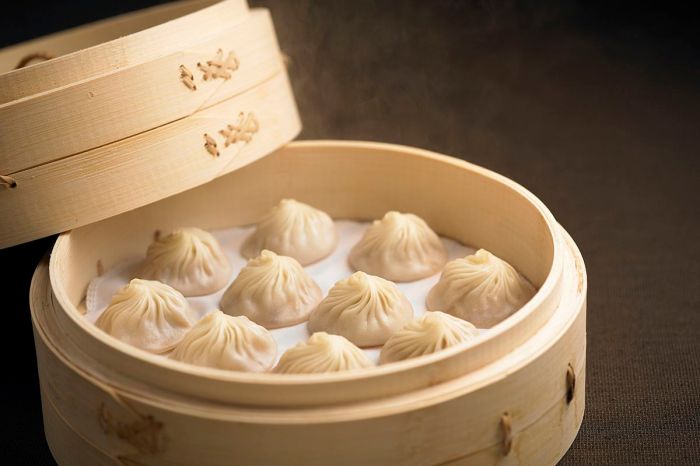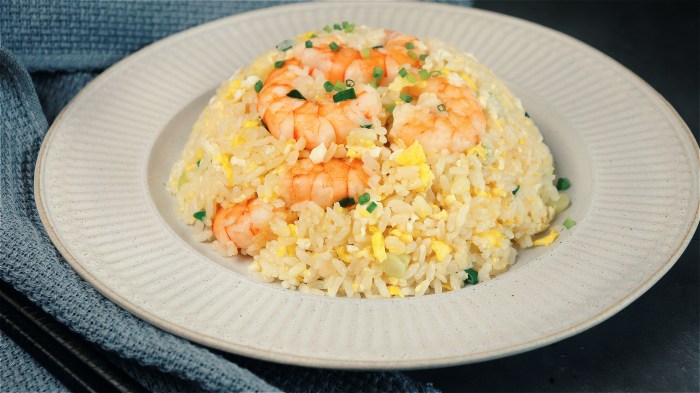Din tai fung taiwanese cabbage recipe – Embark on a gastronomic journey with Din Tai Fung’s Taiwanese Cabbage Recipe, a culinary masterpiece that embodies the essence of Taiwanese cuisine. This delectable dish, renowned for its vibrant flavors and tender texture, has captivated taste buds worldwide. Dive into its history, ingredients, cooking techniques, and cultural significance to unravel the secrets behind its enduring popularity.
Din Tai Fung, a globally recognized Taiwanese restaurant chain, has elevated the humble cabbage into an extraordinary culinary experience. Their signature Taiwanese Cabbage Recipe is a testament to the restaurant’s dedication to authenticity and the pursuit of culinary excellence.
Introduction to Din Tai Fung’s Taiwanese Cabbage Recipe

Din Tai Fung is a world-renowned Taiwanese restaurant chain known for its exceptional dim sum and noodle dishes. Among its many delectable offerings, the Taiwanese cabbage is a beloved menu staple.
Taiwanese cabbage, also known as napa cabbage or Chinese cabbage, is a versatile vegetable widely used in Asian cuisine. Its mild flavor and crunchy texture make it an ideal ingredient for various dishes, including stir-fries, soups, and salads. At Din Tai Fung, Taiwanese cabbage is meticulously prepared to create a flavorful and authentic Taiwanese dish.
Significance of Taiwanese Cabbage in Din Tai Fung’s Menu
Taiwanese cabbage holds a significant place on Din Tai Fung’s menu due to its cultural significance and culinary versatility.
- Cultural Significance:Taiwanese cabbage is a staple ingredient in many traditional Taiwanese dishes, including stir-fried cabbage with garlic and braised cabbage with pork belly. By incorporating Taiwanese cabbage into its menu, Din Tai Fung pays homage to the culinary heritage of Taiwan.
- Culinary Versatility:Taiwanese cabbage is a highly versatile vegetable that can be cooked in various ways. Din Tai Fung utilizes this versatility to create a range of dishes featuring Taiwanese cabbage, including stir-fries, soups, and salads.
Ingredients and Preparation

Din Tai Fung’s Taiwanese cabbage recipe calls for fresh and high-quality ingredients. The cabbage should be crisp and tender, while the pork should be lean and flavorful. The following is a list of ingredients and their preparation methods:
Ingredients
- 1 head of napa cabbage, shredded
- 1 pound ground pork
- 1/2 cup soy sauce
- 1/4 cup rice wine
- 1 tablespoon sesame oil
- 1 teaspoon ground white pepper
- 1/4 cup chopped green onions
Preparation, Din tai fung taiwanese cabbage recipe
- In a large bowl, combine the cabbage, pork, soy sauce, rice wine, sesame oil, white pepper, and green onions. Mix well.
- Heat a large skillet over medium heat. Add the cabbage mixture and cook, stirring occasionally, until the cabbage is wilted and the pork is cooked through.
- Serve immediately with rice or noodles.
Cooking Techniques

Din Tai Fung’s Taiwanese cabbage recipe involves a meticulous blend of cooking techniques that contribute to its signature flavor and texture. Stir-frying is the primary method used to cook the cabbage, which involves tossing the vegetable in a heated wok with a small amount of oil.
Stir-frying
During stir-frying, the cabbage is constantly moved and tossed to ensure even cooking and prevent burning. The heat of the wok caramelizes the natural sugars in the cabbage, resulting in a slightly sweet and savory flavor. The technique also helps retain the cabbage’s crisp texture while softening it slightly.
Seasoning
Seasoning plays a crucial role in enhancing the cabbage’s flavor. Din Tai Fung uses a combination of soy sauce, sesame oil, and rice wine to create a harmonious balance of salty, nutty, and umami flavors. The seasonings are added gradually during stir-frying to allow them to penetrate the cabbage and develop their full potential.
Achieving the Desired Texture
The desired texture for the cabbage is tender yet slightly crunchy. To achieve this, the cabbage is stir-fried for a short period, just until it begins to wilt and soften. Overcooking can result in a mushy texture, while undercooking can leave the cabbage tough and fibrous.
Creating the Signature Din Tai Fung Flavor Profile
Din Tai Fung’s Taiwanese cabbage recipe is renowned for its unique flavor profile that combines sweetness, saltiness, and umami. This signature flavor is achieved through the careful selection of ingredients, precise seasoning, and meticulous cooking techniques. The use of high-quality cabbage, fresh garlic and ginger, and premium soy sauce contributes to the overall flavor complexity.
Presentation and Serving Suggestions
Traditionally, Taiwanese cabbage is presented as a whole or half head, steamed and topped with a savory garlic sauce. The dish is often served family-style, accompanied by a bowl of rice and other side dishes.
To enhance the dish’s presentation, consider garnishing it with chopped cilantro, scallions, or chili peppers. These additions provide a vibrant contrast to the cabbage’s pale green color and add a touch of extra flavor.
Accompaniments
- Steamed rice: The perfect accompaniment to absorb the flavorful sauce.
- Braised pork belly: A classic Taiwanese dish that pairs well with the cabbage’s delicate flavor.
- Oyster sauce: A savory and slightly sweet sauce that complements the cabbage’s natural sweetness.
Pairing with Other Delicacies
- Beef noodle soup: A hearty and flavorful soup that balances the cabbage’s lightness.
- Bubble tea: A refreshing and popular Taiwanese beverage that complements the dish’s savory flavors.
- Stinky tofu: A unique and pungent dish that provides a contrasting flavor experience.
Variations and Substitutions
Din Tai Fung’s Taiwanese cabbage recipe offers a versatile base for culinary exploration. Cooks can experiment with various ingredients and seasonings to create unique and flavorful dishes.
Consider adding other vegetables to enhance the texture and nutritional value of the recipe. Broccoli florets, sliced carrots, or diced bell peppers can complement the cabbage well.
Substituting Ingredients
Dietary restrictions or personal preferences may necessitate ingredient substitutions. For those with gluten intolerance, soy sauce can be replaced with tamari or coconut aminos.
To cater to vegan diets, the oyster sauce can be substituted with a vegan alternative, such as a mixture of soy sauce and vegetable broth.
Customizing the Recipe
Individual tastes can be accommodated by adjusting the seasonings. For a spicier dish, add a pinch of chili flakes or a drizzle of chili oil.
To enhance the umami flavor, consider adding a teaspoon of mushroom powder or a splash of fish sauce.
Nutritional Value and Health Benefits: Din Tai Fung Taiwanese Cabbage Recipe
Taiwanese cabbage is a nutrient-rich vegetable that offers various health benefits. It is a good source of vitamins, minerals, and fiber.
One cup of cooked Taiwanese cabbage contains approximately:
- Vitamin A: 5% of the Daily Value (DV)
- Vitamin C: 50% of the DV
- Vitamin K: 100% of the DV
- Folate: 15% of the DV
- Potassium: 10% of the DV
- Manganese: 10% of the DV
- Fiber: 2 grams
Potential Health Benefits
Consuming Taiwanese cabbage may provide several health benefits, including:
- Improved digestion:The fiber in Taiwanese cabbage helps promote regular bowel movements and maintain a healthy digestive system.
- Reduced inflammation:Taiwanese cabbage contains antioxidants that may help reduce inflammation throughout the body.
- Boosted immunity:The high vitamin C content in Taiwanese cabbage supports a healthy immune system.
- Stronger bones:Vitamin K is essential for maintaining strong bones and preventing osteoporosis.
Serving Sizes and Calorie Counts
A typical serving size of cooked Taiwanese cabbage is about 1 cup. This serving contains approximately 25 calories.
Cultural Significance and History

Taiwanese cabbage holds a significant place in Taiwanese cuisine, with its origins deeply rooted in the agricultural traditions of the island nation. Its versatility and affordability have made it a staple ingredient in many households and a popular choice in restaurants across Taiwan.
Din Tai Fung, a world-renowned Taiwanese restaurant chain, has played a pivotal role in popularizing Taiwanese cabbage globally. Their signature dish, Xiao Long Bao (steamed pork dumplings), often features a filling made with Taiwanese cabbage, introducing the unique flavors of this vegetable to diners worldwide.
Role in Taiwanese Culture
In Taiwan, Taiwanese cabbage is not merely a culinary ingredient but also holds cultural significance. It is often associated with traditional festivals and celebrations, such as the Lunar New Year, where it is believed to symbolize prosperity and good fortune.
The consumption of Taiwanese cabbage is also deeply ingrained in Taiwanese family life, with many households preparing it as a regular side dish or incorporating it into soups, stews, and stir-fries.
FAQ Compilation
What is the secret to Din Tai Fung’s signature flavor profile?
Din Tai Fung’s chefs meticulously balance fresh, high-quality ingredients with traditional cooking techniques to create their distinctive flavor profile.
Can I substitute other vegetables in this recipe?
Yes, you can experiment with different vegetables such as bok choy, spinach, or carrots while maintaining the core cooking techniques.
What are the health benefits of consuming Taiwanese cabbage?
Taiwanese cabbage is rich in vitamins A, C, and K, providing antioxidant and anti-inflammatory properties.